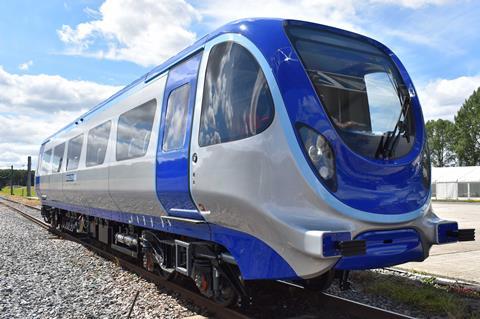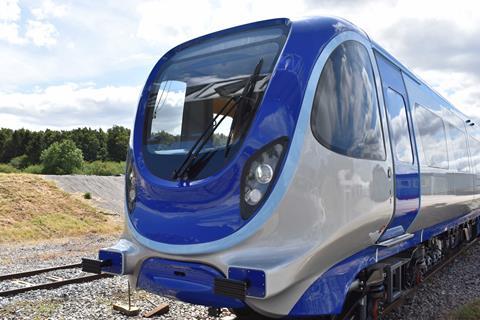
UK: Assembly of the prototype Revolution Very Light Rail vehicle has been completed, and is it now ready for testing to assess the feasibility of providing passenger services on low-traffic and feeder routes where the high cost of conventional rolling stock is currently a barrier to operations.
The demonstrator vehicle has been produced by the Revolution VLR Consortium led by Transport Design International and including safety and standards body RSSB, leasing company Eversholt Rail, Warwick Manufacturing Group at the University of Warwick, engine supplier Cummins, Coventry-based autonomous pod manufacturer RDM Group and Transcal.
The 18 m long bidirectional vehicle has a bodyshell made from recycled carbon fibre, with the prototype configuration having a capacity of 56 seated passengers.

The Cummins engine and diesel-electric powertrain is adapted from automotive technology, and gives a maximum speed of 105 km/h. There is a lithium titanate battery pack for regenerative braking and to enable zero-emission operation at up to 30 km/h in stations and built-up areas.
The vehicle is intended to be suitable for operation on heavy rail infrastructure, rather than tramways, but special procedures would need to be adopted to permit mixed operation with conventional trains.
The demonstrator is to undergo validation tests at the Rail Technology Centre in Long Marston, and will then go to a rail-connected site in Ironbridge for demonstration to potential operators from October.
The VLR research programme has its origins in the Radical Train programme launched by the Rail Safety & Standards Board in 2014, with TDI proposing a lightweight self-propelled railcar that eventually became the Revolution VLR concept and was awarded government for development.
RSSB has identified 35 routes that could be suitable for VLR, and several operators have expressed interest.
‘Revolution VLR’s design and performance characteristics make it an attractive and sustainable rolling stock solution for many of the line reopenings being proposed through the Restoring Your Railway programme’, said Tim Burleigh, Head of External Relations at consortium member Eversholt Rail, on August 12. ‘It is highly cost-effective, which will assist scheme sponsors in developing compelling business cases against the backdrop of an increasingly challenging economic environment.’
Luisa Moisio, Head of Research & Development at RSSB, said Revolution VLR would ‘combine the best of state-of-the-art technology from both rail and automotive sectors to offer a significantly cheaper and lower emission solution for branch lines.’
She added that RSSB is ‘excited about the Revolution VLR demonstrator vehicle’s fast progress toward launch later this year. This is proof of the great innovation that can and will take place when boundaries are pushed, radical ideas are encouraged and adequately supported, and strong collaborations across transport sector are established and fostered.’
Some of the consortium members are involved in a separate project to develop a prototype lightweight low-floor tram for Coventry.



